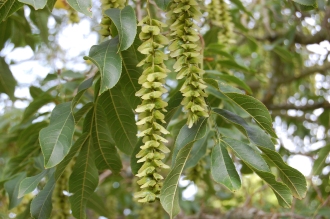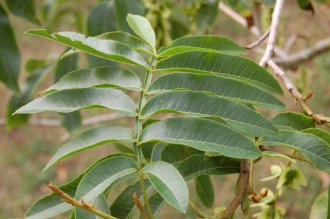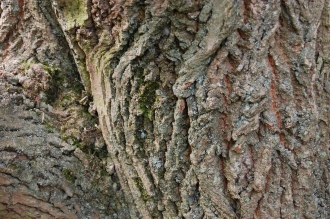
Juglans major (15/08/15, Kew Gardens, London)
Position: Full sun
Flowering period: Late spring to early Summer
Soil: Moist, well drained
Eventual Height: 15m
Eventual Spread: 15m
Hardiness: 7a, 7b, 8a, 8b, 9a, 9b
Family: Juglandaceae
Juglans major is a fast growing, deciduous tree with a broad crown. Its bright green leaves are odd-pinnate, composed of up to 19 leaflets and up to 32cm long. Its leaflets are lanceolate with serrulate margins, hairy when young, up to 10cm long and 4cm across. Its branches are light grey with rufous hairs when young, becoming dark grey to brownish black and glabrous as they mature. Its trunk may achieve a diameter of 1.3m. Its bark is grey/ black and deeply furrowed. The species is monoecious. Male yellow/ green flowers are in the form of drooping catkins which are up to 20cm. Its green female flowers are small and insignificant, are terminal and appear solitary or occasionally in pairs. Its fruit are green/ brown, almost round, up to 3.5cm across when ripe in autumn and contain edible walnuts.

Juglans major Leaf (15/08/15, Kew Gardens, London)
Juglans major, commonly known as the Arizona Walnut, Arizona Black Walnut or Nogal Silvestre, is native to south west North America, predominantly Mexico. In its native habitat it usually grows in dry rocky ravines and stream beds. Juglans major is synonymous with Juglans elaeopyren, Juglans microcarpa var. major and Juglans rupestris.
The etymological root of the binomial name Juglans is from the classical Latin name for Juglans regia. Major is derived from the Latin meaning ‘greater’.
The landscape architect may find Juglans major useful as a large fruiting tree, it may be suitable for a community garden where space allows. It is also suitable as an attractive parkland tree. Care should be taken in locating this tree as its roots, leaves and nut husks secrete a substance, Juglone, into the soil which inhibits the growth of some plants.

Juglans major Bark (15/08/15, Kew Gardens, London)
Ecologically, Juglans major fruit are attractive to some birds and mammals who eat its nuts.
Juglans major prefers moist, humus rich, deep, well-drained soils. It tolerates most pH of soil. It is especially tolerant of alkaline conditions.
Juglans major requires little maintenance. Necessary pruning should be carried out in late summer to early autumn while the tree is fully dormant. Suckers should be removed as the appear.

Landscape Architecture














